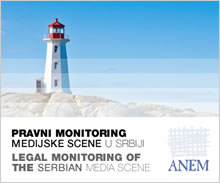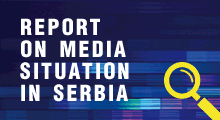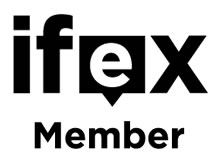23. 12. 2013
ANEM MONITORING ROUND TABLE IX
ANEM presented its Ninth Monitoring Publication, second in 2013, at the Monitoring Round table IX that it organized on December 23, 2013 in Belgrade. The articles in the Publication refer to media pluralism, ethics in the media as well as judicial practice of domestic courts as well as the European Court of Human Rights, in the media disputes. Therefore, among over 50 participants of the round table, there were students and teaching staff of the University of Belgrade Faculty of Law, students of the Faculty of Law of the Union University in Belgrade, professor of the Faculty of European Law and Political studies from Novi Sad, judges of the Appellate and High Court in Belgrade and lawyers. Apart from them, representatives of relevant state authorities were also present (Ministry of Culture and Information, Ministry of Foreign and Internal Trade and Telecommunications, Commissioner for Information of Public Importance and Personal Data Protection, Ombudsman, The Intellectual Property Office of the Republic of Serbia, Anti-Corruption Agency, Culture and Information Committee of the National Assembly of the Republic of Serbia), regulatory and self-regulatory bodies (RBA and RATEL, Press Council), representative of Sokoj (Serbian Music Authors' Organization), donor and international community (Embassy of the Kingdom of the Netherlands, Open Society Foundation, OSCE, USAID), media community (journalists and media - RTV B92, RTS, Tanjug, Novosti, Beta; media associations NUNS and UNS), as well as media experts and civil society organizations (ECRS, YUCOM, Share Defense, Civil initiatives) and other interested parties.
Milorad Tadic, the President of ANEM, was the moderator of the round table.
The Publication was presented by the authors of the texts, followed by discussion on the topics covered in the texts.
PRESENTATION OF THE PUBLICATION
Slobodan Kremenjak, attorney at law and Head of ANEM monitoring team, presented his text "Delfi v. Estonia from the Serbian Perspective", in which he dealt with the liability of the media for the media portals and websites visitors' comments as well as the issue of the freedom of expression on the Internet. As a starting point, he used a recent verdict of the European Court of Human Rights in the case Delfi As v. Estonia, where the Court confirmed the position of Estonian courts - that Delfi As, the owner of Delfi portal, is responsible for non-material damage caused to the owner of one shipping company by the visitors' comments published on that portal (which is the practice of the Serbian courts as well). That verdict caused a storm of disapproval in Europe due to the potential limitation to the freedom of expression on the Internet, while such verdicts in Serbia are passed almost with no reactions at all. Kremenjak said that the key issue in this and similar cases (debated widely by experts in Europe), was the question of treatment of visitors' comments on websites and portals i.e. whether these comments were treated as part of a content media was responsible for (editorial media content) or they were treated as a service of the information society, for which media were not held directly responsible or were responsible only if prior to publishing, they were warned of the existence of some indecent comment, but did not remove it nonetheless. From freedom of expression's point of view, comments can contribute to the debate on some important questions, or they can be misused; however, if the responsibility for readers' comments is put solely on the media, that creates an atmosphere in which a private company can decide what can be published or not, which represents great danger for the freedom of expression. As for the media, this is an important practical question for them, since some breaking news have hundreds of comments, not possible to be moderated ahead of time, especially in conditions of a difficult economic crisis and employee layoffs; also moderating can contribute to the decrease of visits, i.e. to the decline in profit from portals/sites, which is very bad, having in mind, that Internet is the only platform that has an increase of profit from advertizing. Therefore, it is very important that the media initiate debate among themselves on how to respond to this problem, because media in Serbia are in the situation to be responsible for the content they cannot entirely control.
Milos Stojkovic, a member of ANEM monitoring team, the author of the text "Do Draft Media Laws Foster Media Pluralism?", pointed out two important elements of media pluralism: the internal (referring to content - pluralism of a broad scope of information, of all political orientations, of national and local importance, important to the marginalized groups, minorities etc) and the external (referring to structure - number of media, owners etc). The Media Strategy of Serbia stated three important elements for media pluralism: ownership (which in itself contains 2 elements - transparency of media ownership and finding a quantitative criteria for the threshold of unlawful media concentration), diversity of information sources (number of media, but it has to be put in the context with the other two elements) and diversity of media content (the most important element in estimating pluralism of opinions, ideas and information). The main promoter and carrier of media pluralism in this context should be public service broadcasters. The main challenge in studying this topic is the question of diversity of the media content, since that element is missing in the current legislation and draft laws, too. Closely related to that question is the question of efficient separation of editorial and ownership function - Stojkovic gave the Draft Law on Public Service Broadcasters as an example, which Draft declaratory introduces the separation of the ownership structure (public service broadcasters are owned by citizens and are being financed from public funds) and editorial control; however, the way the financing of public service broadcasters was changed from a TV subscription fee to the budget funds, is not good, since in this way the state can significantly influence the independence of editorial policy. That is one of the challenges we are facing in media pluralism, since there are no efficient mechanisms to provide independent editorial control. The biggest problem which was to be solved prior to creation of the Media Strategy and laws is the lack of adequate analysis of media market (according to European standards, media pluralism is viewed from the perspective of concrete media market), which requires qualitative and quantitative analysis. The quantitative analysis would refer to the diversity of information sources (i.e. if there is large enough number of media, pluralism of ownership), while the qualitative one would answer the question on the market value and the type of content placed at specific media market. Only then the regulation of protection of media pluralism and media concentration come as important. Third very important question, posed by Stojkovic, was who would carry out the monitoring of application of the regulation in the area of media concentration and protection of media pluralism. Stojkovic cited the recommendation given by the Council of Europe referring to finding other efficient mechanisms when mechanisms of the protection of freedom of competition are not sufficient and asked if regulatory body RBA and the Ministry of Culture and Information, projected by the draft laws to do the monitoring, were equipped enough and had enough capacities to do it, without participation of the Commission for Protection of Competition. His conclusion was that draft media laws deal only with one aspect of media pluralism - media concentration, and that a reverse logic was implemented in regulating the area of media concentration, which was to find a solution without precisely defining a problem. In practice, that can cause new problems it would not be easy to solve, together with all the current challenges on the media market.
Dragica Popesku, PhD, the judge of the Appellate Court in Belgrade, the author of the text "Some Debatable Issues in Disputes Between Authors of Photographs and the Media", listed three key controversial issues judges face in the said disputes: 1) Key question is whether every photograph, appearing in the damage compensation proceedings before the court, is a copyrighted work. To answer that question, it is important to start from the definition which says that copyrighted work is an original intellectual creation regardless of its scientific, cultural or other value, as well as the fact that copyright work includes motivation, awareness and knowledge; therefore, the answer is that not every photograph is a copyrighted work. This question is important due to inflow of claims by individual plaintiffs, whose photographs were taken by media through internet search engines without their approval. It is also important to assess if the person that claims is the creator of that photograph; 2) Second important question is how to estimate the amount of compensation of material or non-material damage for the infringement of copyrighted work in the area of photography; 3) Third question is whether pecuniary compensation of non-material damage could be replaced by non- pecuniary one, using the retraction, which is a practice in German law, but is also in accordance with the Provision of Article 199 of the Law on Obligations which refers to non-pecuniary compensation of non-material damage. Until the infringement of the right itself is not introduced as damage in our legislation, one of important things to be assessed by the court, when it comes to compensation of non - material damage (suffered emotional pain or fear), is whether the unauthorized publishing of the photograph caused a disbalance in psychological personality of the plaintiff. If the disbalance occurred, the question is if it can be restituted in obtaining non - pecuniary compensation of damage in a form of apology, retraction, withdrawal of the statement, the correction of information or publishing of the judgment which will determine the infringement of rights, or the infringement of integrity was so deep that the satisfaction can only be achieved by pecuniary compensation. In that case, the court is obliged to estimate the amount of money which will reinstate the plaintiff to where he/she was prior to his/her photograph was published in some media without approval, and that the amount is adequate to the damage, and that lucrative tendencies of certain plaintiffs and their attorneys are avoided. It should be noted that journalists and editors of media outlets are not responsible based on the objective responsibility, but subjective, which means it needs to be assessed how much they contributed to the damage - whether their damaging action existed, if there was a damaging consequence, if there was a causal relationship and if there was illegality as the fourth element which is not always important.
Tamara Skrozza, journalist of weekly "Vreme" and member of the Complaint Commission of the Press Council, the author of the text "Ethics in the Media: Mistakes, Self-regulation and Raising of Standards", said that ethics exists in the Serbian media and that majority of journalists respect ethical standards, but that a minority of journalists who do not respect those standards smear the work of other journalists. Ethic standards are respected the least by the print and electronic media with the highest coverage. On the other hand, our public media space is absolutely unethical, which is the result of general lack of ethics in our society, as well as bad conditions media work in. This year was full of so called "innovations" in breaching the ethical standards. One of them refers to campaigns which gained hysterical proportions and which contributed to jeopardizing of reputation not only of politicians (for example Sonja Biserko, Dragan Djilas), but ordinary people as well (for example family Ognjanovic). First negative consequence of campaigns is the destruction of lives of people, subjects of campaigns. Second important consequence is that, through these campaigns, topics of extreme public importance are devalued and media do not dare to deal with them anymore, and especially not in some different way. In addition to this, the novelty is the fact that media started running campaigns against other media - for example in the case of TV Pink against daily „Blic" in which unethical reporting of "Blic" generated even less ethical response by TV Pink. „Innovation" that also appeared is the blind faith or „copy paste"- literal reporting on what was said to journalists by relevant sources (the case of Jovanka Broz which will enter the annals of shame of both journalists and doctors); however, the journalists are the ones who have to know they are not supposed to convey something that can jeopardize the person they are reporting on. The cited innovations represent main tendencies when it comes to ethics in our media. Skrozza spoke of the work of the Complaint Commission of the Press Council, but also on possible cease of its work due to lack of funding.
DISCUSSION
After the presentation of the Publication, following issues were discussed: how legitimate it is to expect the separation of ownership and editorial function in commercial media in the context of media pluralism - the conclusion is that it cannot be expected that this separation of functions in commercial media will be 100 percent, having in mind the commercial nature of these media, but that in the context of media pluralism, an efficient mechanism should be found - a balance between commercial interest and interest in the protection of media pluralism, in order to avoid that the ownership completely determines editorial policy; on the responsibility of media for online comments of the media websites and portals' visitors - our courts hold media responsible for comments' content, even though according to the Law on Electronic Trade, comment is an information society service; therefore the practice of our courts should change; if there is further insisting on media being responsible for comments, this would result that media, for the reason of caution, remove everything that can be even slightly problematic or would not publish it, which can "kill" a debate; on problem of insufficient number of staff to moderate all the comments and their capacity to estimate what is allowed to publish and what must not be published as well as the criteria to do it; about the fact that author is always responsible for the comment, even if he/she is anonymous, that the right to anonymity is part of the right to freedom of expression, but that it is possible to discover the identity of anonymous author with the court warrant; that there is no concept of limitless irresponsibility for comments' content, and that the media becomes responsible for comments if warned on its inadequacy and still does not remove it; also, that there is no objective responsibility of media for every comment, but that it is subjective and has to be assessed in each concrete case; on criteria which determine a photograph as copyrighted work, which generated a conclusion that it is necessary for court to take a stand on the criteria for determining which photograph is copyrighted work and which one is not, as well as the stand related to compensation for non-material damage - that it has to be preferably determined according to the Article 199 of the Law on Obligations, namely that non-pecuniary compensation is preferable to pecuniary one; that a plaintiff is obliged to provide evidence that concrete photograph is copyrighted work (together with the claim or at the preliminary hearing) or to submit a motion for a hearing of an expert witness on that circumstance, as well as that he/she has to prove non-material damage - i.e. if he suffered emotional pain or fear; in all the claims for the compensation of non-material damage, there must be the infringement of right to psychical integrity; the question was posed what stops some newspapers being banned in case they keep breaching ethical standards, the answer was it was democracy, but that ban was not a solution - instead, the media need to be brought to order by self-regulation and regulation. During the discussion, Sasa Mirkovic, Assistant Minister of Culture and Information announced that drafts of the Law on Public Service Broadcasters and Law on Electronic Media would be sent for comments to 10 relevant addresses in the course of that week, after the Workgroup finished assessment of 400 pages of comments from public discussions related to the drafts of these two laws and incorporated some of those comments in the drafts. Regarding the Draft Law on Public Information and Media, he emphasized that a positive opinion came from the Ministry of Foreign and Internal trade and Telecommunications and said that two more are to come from the Ministry of Finance and Ministry of Justice, as well as from the Legislation Secretariat. After obtaining the opinion which will be incorporated in the draft, the draft would be sent, via Government's European Integration Office, to Brussels for further comments. In relation to chapter 10 of Pre-accession negotiations, he informed the participants that the first screening was postponed for May and second bilateral for July, and that the screening would encompass all three media laws, to be adopted in 2014, which will contribute to a more modern legal framework for Serbian media functioning. He said that two days ago, the Ministry published the call for new projects, which would be financed in 2014 and that the call would be open until January 21, 2014. After that, there would be a 45 days deadline for allocation of the funds. He emphasized that the Ministry budget would be 30% higher compared to this year.

The content of this report is the sole responsibility of the authors and does not necessarily reflect the views of the Embassy of the Kingdom of the Netherlands.

The content of this report is the sole responsibility of the authors and does not necessarily reflect the views of the Open Society Foundation, Serbia.
-
No comments on this topic.





